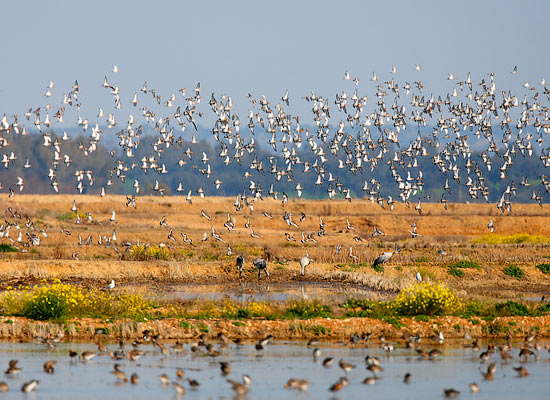| Line 1: | Line 1: | ||
| − | [[Image:casas.jpg]] | + | [[Image:casas.jpg|thumb|550px|right|(SEX, AGE, SUBSPECIES)<br />Photo by Steve Fletcher<br />Typical winter scene at Casas de Hitos]] |
==Overview== | ==Overview== | ||
Casas de Hitos ( house of milestones ) is normally referred to by visiting birders as the "ricefields". Although the ricefields extend from Madrigalejo to Badajoz, over 100km, this small area is the most visited and documented by visitors. An important area for a large proportion of the visiting 70,000 or so Common Cranes overwintering in Extremadura. This area is under threat, as the Government of Extremadura plan to build 100 hectares of solar farm here, along with 50km of high tension overhead cables and pylons to the distribution centre at Valdecaballeros. | Casas de Hitos ( house of milestones ) is normally referred to by visiting birders as the "ricefields". Although the ricefields extend from Madrigalejo to Badajoz, over 100km, this small area is the most visited and documented by visitors. An important area for a large proportion of the visiting 70,000 or so Common Cranes overwintering in Extremadura. This area is under threat, as the Government of Extremadura plan to build 100 hectares of solar farm here, along with 50km of high tension overhead cables and pylons to the distribution centre at Valdecaballeros. | ||
Revision as of 11:27, 15 February 2010
Overview
Casas de Hitos ( house of milestones ) is normally referred to by visiting birders as the "ricefields". Although the ricefields extend from Madrigalejo to Badajoz, over 100km, this small area is the most visited and documented by visitors. An important area for a large proportion of the visiting 70,000 or so Common Cranes overwintering in Extremadura. This area is under threat, as the Government of Extremadura plan to build 100 hectares of solar farm here, along with 50km of high tension overhead cables and pylons to the distribution centre at Valdecaballeros.
Birds
Common Crane is to be found here in huge numbers from October to early March. White Storks overwinter in large numbers here, preferring these wetlands to the long migration to Africa. Bluethroat winter here in large numbers in the overgrown ditches surrounding the managed fields, and are easily found by listening to their snip snip call from the reeds. Huge concentrations of passage waders stop here to refuel for a few weeks every autumn and spring, including Black-tailed Godwit, Ruff, Little Stint, Temminck's Stint, Wood Sandpiper, Avocet, Dunlin and Golden Plover. Collared Pratincole and Little Ringed Plover breed here when the fields are dry. Cettis Warbler, Red Avadavat, Common Waxbill, Zitting Cisticola and Melodious Warbler are numerous. Great and Little Bustards can be seen here, but the tall vegetation makes it rather difficult, and Black-bellied Sandgrouse often give good views.
Rarities
Kentish Plover have bred here since 2008, a first for Extremadura. Casas de Hitos is an excellent place to see Black-shouldered Kite that breed and feed here.
Check-list
Birds you can see here include:
To do
Other Wildlife
Egyptian Mongoose can be seen reguarly here, usually in small family parties of 5 or 6.
Site Information
History and Use
Rice has been grown is Spain for over 1200 years, but the area here was developed in the 1950's, when the large rivers were dammed, providing the vast amounts of water required for the irrigation of the dry fields.
Areas of Interest
The large pool, or charca, to the north of the entrance to the Casas de Hitos complex holds many wintering Greylag Geese, Egrets, Herons, Shoveler, Pochard, Pintail and Grebes.
Access and Facilities
Take the road from Zorita to Madrigalejo, past the entrance to Embalse de Sierra Brava, past the old railway station, and along the line of Eucalyptus lining the main road. At the end of these trees is the Pension Maybe, turn left here, through about 4 km of open grassland and oak wood, and you will come to the rice fields of Casas de Hiotos.
Contact Details
To do
External Links
To do




